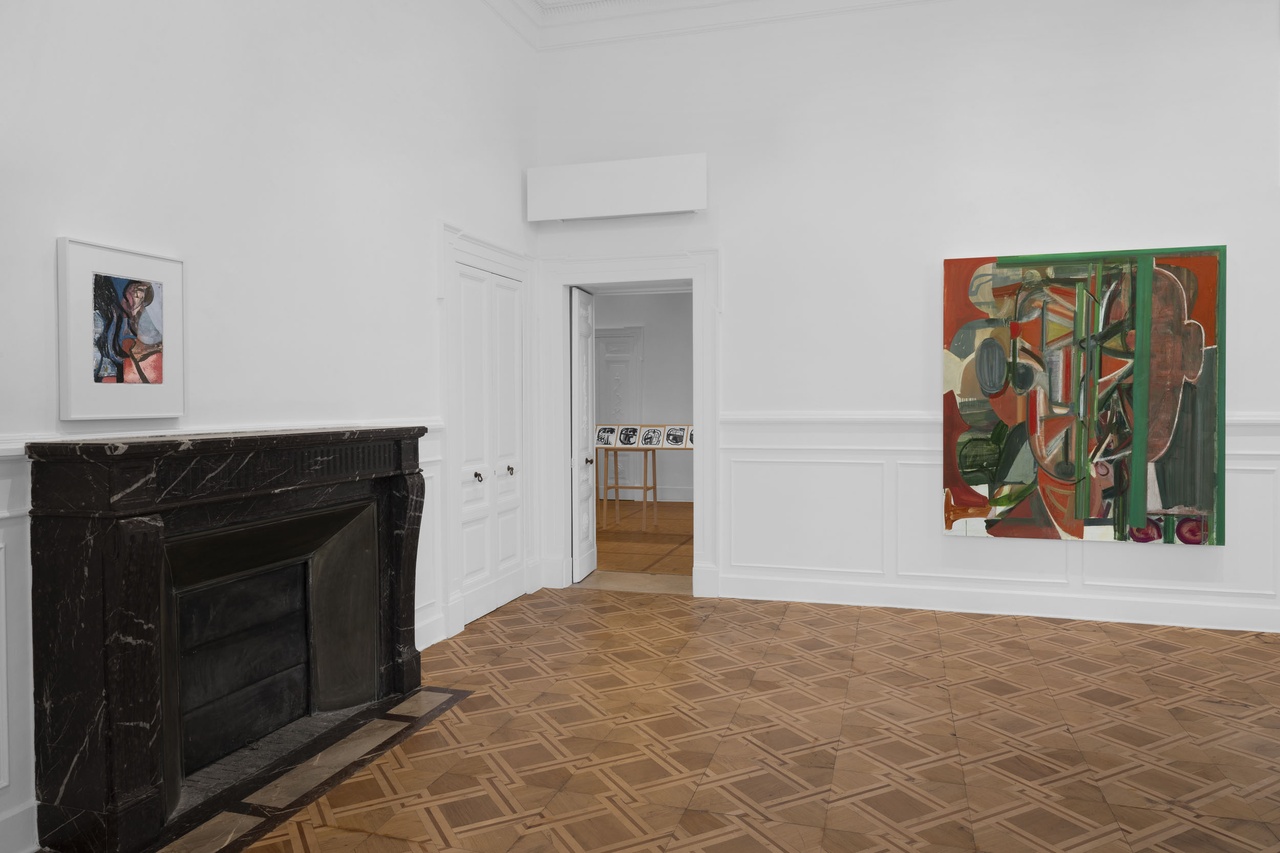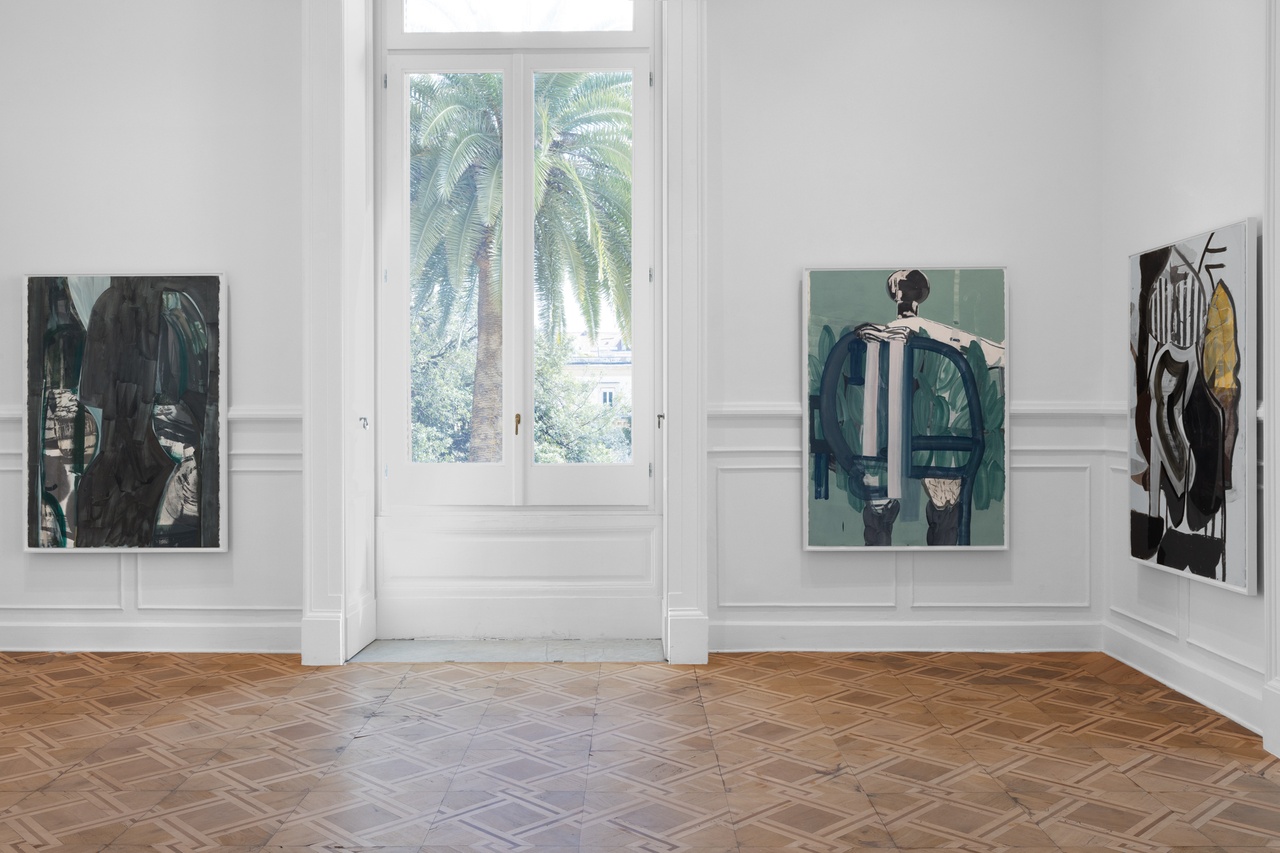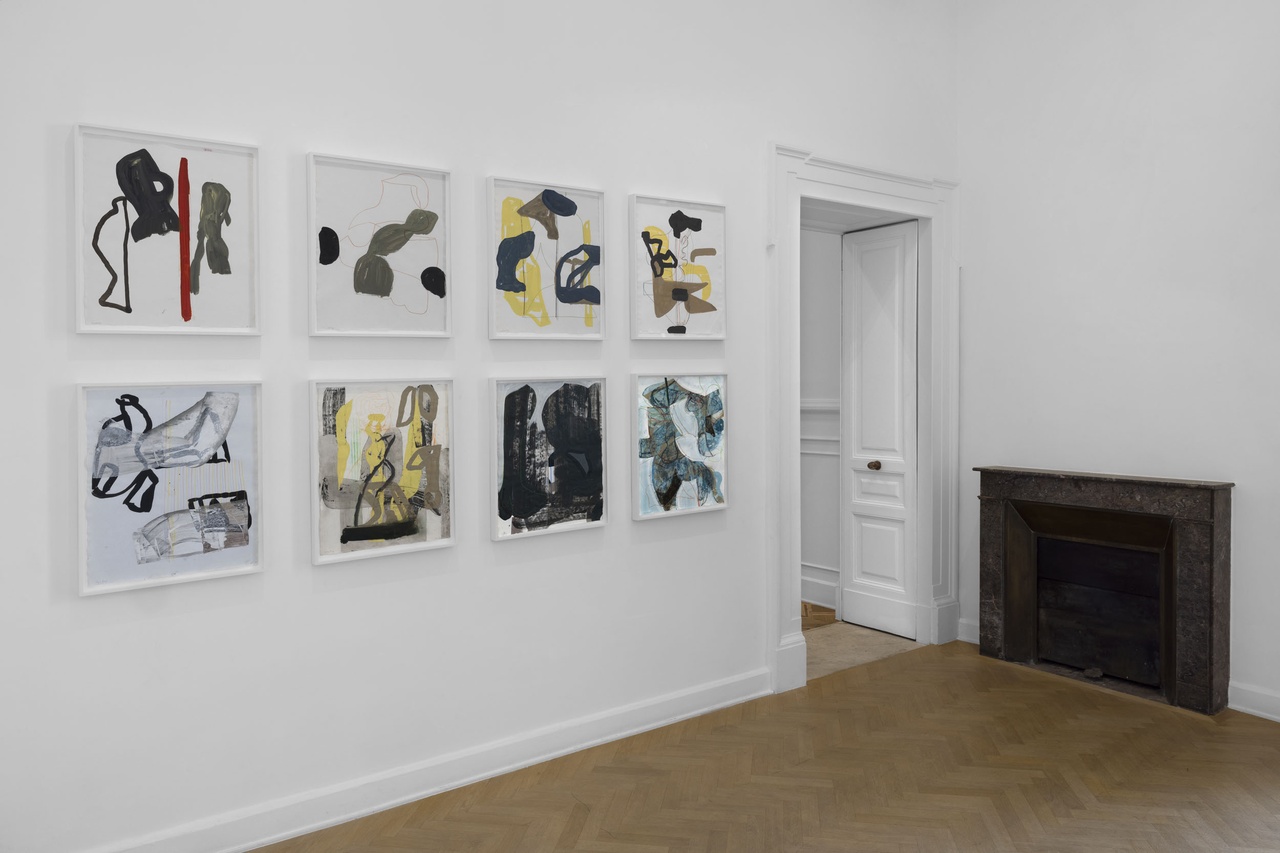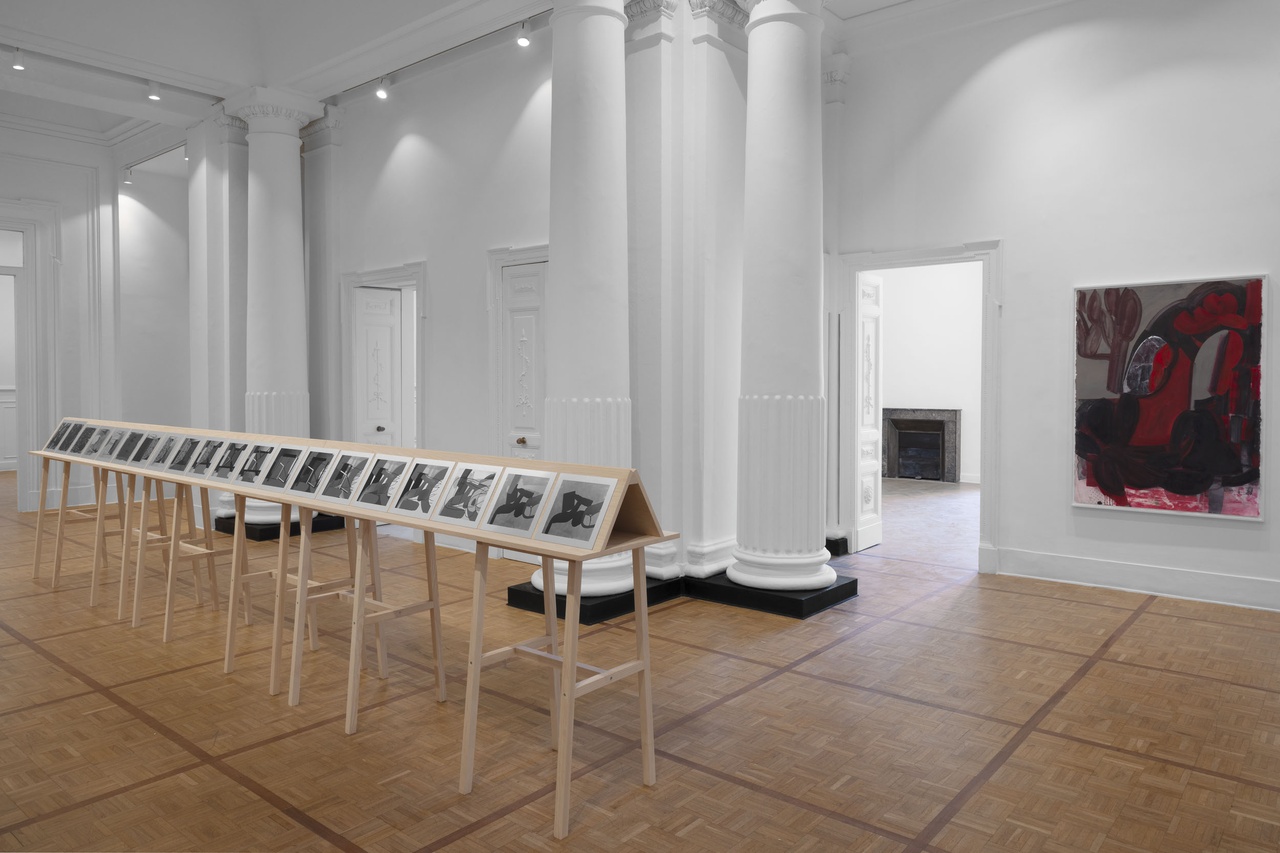THE FLESH OF THESE CHANGES Rose Higham-Stainton on Amy Sillman at Thomas Dane Gallery, Naples

“Amy Sillman: Temporary Object,” Thomas Dane Gallery, Naples, 2023, installation view
In T. J. Clark’s defense of Abstract Expressionism, the art historian speaks of vulgarity’s associations with class and the ways in which painters like Jackson Pollock and Willem de Kooning describe, and willingly take part in, “a particular triumph and disaster of the petit bourgeoise.” [1] What Clark failed to see – or say – is that vulgarity is also gendered. [2] Era Vulgaris denotes common era but also common mistress, and there is no masculine equivalent – no common master. It is the female body, rendered infinitely and indiscriminately abundant, that has given form to such vulgarity – one of pure matter before it is cultured by man into something – like painting.
In “Temporary Object” at Thomas Dane Gallery in Naples, Amy Sillman, whose practice is entangled but not compliant with Abstract Expressionism, imagines vulgarity as something more than simply crude, profane or discriminatingly gendered. She prizes it from the body object and assumes it as a kind of shared space for the opening up of painting: a space that can hold many things at once, that can hold masses. Like Susan Sontag’s camp, Sillman’s vulgarity says FUCK DECORUM, exposing herself and the various stages and seams of her work – work in which pigments touch and clash, sidle up to one another, embolden one another or drown each other out. In her Naples show, Sillman becomes explicit about process, situating painting as a time-based medium and capturing it at the various stages of becoming and unbecoming and becoming again, or what she refers to as the “drama of production.”

“Amy Sillman: Temporary Object,” Thomas Dane Gallery, Naples, 2023, installation view
It is apt that Sillman’s work has found its way to Naples – a city of highs and lows, where the legacies of trade with the east, Arte Povera, and Maradona come to touch; where sheer hillsides meet deep ravines; where buildings are scorched pink and yellow by the sun and confronted by the cool azure sea; and where men pull at the metal strings of their guitars before the sound fractures under the weight of a Vespa exhaust. Repetition, Gertrude Stein once said, is only ever insistence, and Naples repeats itself – insists itself – upon you. [3]
Sillman made all the works for “Temporary Object” in her Bushwick studio. They do not refer to Naples in any explicit sense, but the works and city resonate with one another. The windows of Thomas Dane Gallery have been thrown open, admitting the breeze and the caws of birds and the view of the bay. Sillman, on her part, has responded to rather than complied with the space through the way she has hung the show. Works like Torso with Green (2023) mirror the arch of a window frame; others loosely evoke a leaning palm or the curvature of the Bay of Naples.
Amy Sillman makes paintings that are also drawings, actions, gestures, comedies. Paintings that hold lots of things at once; paintings that take you right up to the frayed edges of the paper that the artist likes to work on. Sillman grew up and into painting in New York, where, aside from a period she spent teaching in Germany, she continues to live and work. She was a “punk kid” and art student in the early seventies, which were strongly marked by the influence of Abstract Expressionism – a movement largely defined by “phallic she-males” like Pollock and de Kooning or “fake-dude-women,” such as Helen Frankenthaler, Lee Krasner, and Joan Mitchell, Sillman said. [4] Abstract Expressionism’s lazy gender essentialism was epitomized by the critic Clement Greenberg, who defined it as a “pure and transcendental optical experience” – the kind of thing you can’t touch or grasp. Other movements and entire epochs would subsume and be subsumed by Abstract Expressionism, while women and people of color would fall foul of its historical canon. Sillman has spent 50 years performing a “critique of the critique, […] one that allowed me to appropriate AbEx as a practice back into my own hands and twist it into the form I wanted it to assume.” [5]

“Amy Sillman: Temporary Object,” Thomas Dane Gallery, Naples, 2023, installation view
Sillman’s contortion of gender and painting extends to drawing, zine-making and, perhaps most importantly, writing, which she uses to situate not only her own work but also the work of others. So much so that it can be hard to write about Sillman without also writing in Sillman; she invites us to enter the work, and we reciprocate by allowing her to speak for herself. By expressing her own thoughts through the works and lives of others, Sillman draws people like the painters Louise Fishman and Amelie von Wulffen close to and into her writing and negates the idea of a practice as some hermetically sealed container or precious object. In her collection of writing titled Faux Pas, she describes the work of Carolee Schneemann as “the performance of a visionary activity, one in which form remakes itself continuously, charged with an intense compression that is seeing, feeling, and doubting all at once. It is the task of both building and destroying.” [6]
Despite her associations with performance, Schneemann identified first and foremost as a painter, and her building and destroying of painting, of its confines as a medium and its sense of permanence, is precisely what Sillman demonstrates in “Temporary Object.” It offers not so much a survey of her work but of process – proposing painting not as a physical object but as an event. Against the grain of the building’s conserved grandeur, Sillman exposes the masses of layers and iterations and the irascible, ill-defined, and erased stages that make up a painting, letting the work spill right off the canvas.
Sillman hangs her own shows, and you sense her intuitive movement through the space. A breeze circulates through and around the rooms, and her work follows suit, as if caught on a tailwind. From a central reception room, one room opens into another. There is a series of teal, citric yellow, and black works in ink, colored pencil, and acrylic on paper titled Monday (2022), Tuesday (2022), Wednesday (2022), and so on, reaching around to Next Monday (2022). These give way, in the next room, to larger, brooding paintings such as Torso with Silhouette (2023), which is worked over in black as if being overshadowed by something. Circling back toward the reception room, we are confronted by the fervent pigment of The Bronze Decor (2022), and with Queenie (2023), which features a piglet-pink haunch emerging from deep within the layers of the canvas.
In her essay “On Color,” Sillman writes about how in painting “time merges with materials to form constant changes […]. As a painter who uses color as a material, I could describe color as simply the flesh of these changes – the way I mark the negations of painting time.” [7] As the flesh of these changes, color is gestural – is of the body – sometimes a searing bile yellow, other times a kind of turgid brown wash, turning translucent and purple like a bruise. The aforementioned Torso is not “in” but “with” Green; both are materials of equal weighting. Occasionally, Sillman leaves white space, as if she is keeping the door open on painting.

“Amy Sillman: Temporary Object,” Thomas Dane Gallery, Naples, 2023, installation view
The exhibition space is laid out in such a way as to always return you to the central reception room that Sillman calls “the spine” of the show, or her “studiolo.” This “studiolo” is a wooden display unit, several meters long, that holds a series of UV drawings printed onto sharp aluminum sheets. As both the physical and conceptual spine of the exhibition, Temporary Object (2023) traces the various temporal and visual stages of one single painting, which Sillman perversely omitted from the show. By revealing the manifold gestures and layers that go into a painting, and by not including the “end result,” Sillman makes the case for the work’s durational quality.
The drawings in Sillman’s “studiolo” are based on iPhone photos. They mirror one another in scale and ratio, and are iterative rather than consequential: there is a square like Malevich’s square and then no square; there is a perpendicular line, then no line; there is a jaunty angle, then no angle; there is a square that is also a grid, then no grid; there are a bunch of dark squiggles thick like cartoon storm clouds, then no clouds; there is a shadow of some obfuscatory form, then no shadow. In this namesake work, Sillman strips back all distractions – perhaps also easy associations – with her work. She retracts color and the lashings of paint and underlayers of ink and printing to form a uniform and monochromatic drawing laser printed onto slick aluminum. She is asking us to attend, instead, to the shapes of process, of labor. The 45-degree angle of the display case makes reference to the drafting tables in architectural and engineering practices, as does the sleek texture of aluminum sheets, yet such diagrammatic (or preparatory) function is undermined by the fact that Sillman made these objects in hindsight – or after the event of the painting. What if, Sillman imagines, the “finished” painting was merely an encore? What if drawing kept the score?
In this show, the artist tries knowingly, fails knowingly, and tries again to systematize that which cannot be systematized: her painting process. Temporary Object (2023), or Sillman’s “studiolo” is the first work we encounter when we enter the gallery, encouraging us to read all the other seemingly “complete” works as iterative, lifting their layers of shape and color off the canvas. Drawing also plays a vital role in the exhibition, and small works on paper punctuate the space, hung unassumingly over a mantelpiece or in a corner. Rather than the lowly relative, or preparatory stage of painting, drawing is, for Sillman, its own thing. Rendered in acrylic, ink, and wax crayon, these works are “something surprising, never completed, never final, but circular, a looping act in a continuous present.” [8]
Abstract Expressionism is alive and well in Sillman’s work – not as an epoch or system to adhere to but as a practice where, as she writes, “time goes by in fits and starts, with resistance of materials being part of that time” [9] . Sillman marks time through the flesh of her paintings, with all their abrasions, cracks, and pores. In “Temporary Object,” painting becomes a thing that moves and breathes en masse. You could call it vulgar, or a kind of irreverence toward painting.
“Amy Sillman: Temporary Object,” Thomas Dane Gallery, Naples, April 26–July 29, 2023.
Rose Higham-Stainton writes criticism, essays, and experimental prose in a bid to further feminisms. Her work is published in The White Review, Art Monthly, LA Review of Books, Apollo, MAP Magazine, PIN–UP, The Skirt Chronicles, Worms Magazine, Passe-Avant, and Bricks from the Kiln and is held in the Women’s Art Library at Goldsmiths College. She has published several chapbooks, including Herēma (Sticky Fingers Publishing) and Foam of the Daze (Bottlecap Press), and is currently working on a book about decentralization and art for the interdisciplinary publisher JOAN.
Image credit: © Amy Sillman, courtesy the artist, Gladstone Gallery, New York and Thomas Dane Gallery, photos Roberto Salomone
Notes
| [1] | T.J. Clark, “In Defense of Abstract Expressionism,” October 69 (1994): 23–48. |
| [2] | Amy Sillman, “AbEx and Disco Balls: In Defense of Abstract Expressionism II,” in Faux Pas (Paris: After 8 Books, 2020), 113. |
| [3] | “Miss Stein States There Is No Such Thing As Repetition,” Ann Arbor News, December 15, 1934. |
| [4] | Amy Sillman, “AbEx and Disco Balls: In Defense of Abstract Expressionism II,” in Faux Pas (Paris: After 8 Books, 2020), 115. |
| [5] | Ibid., 120. |
| [6] | Amy Sillman, “Carolee Schneemann: Always a Painter,” in Faux Pas, 240. |
| [7] | Amy Sillman, “On Color,” in Faux Pas, 72. |
| [8] | Amy Sillman, “Further Notes on Shape,” in Faux Pas, 92. |
| [9] | Amy Sillman, “Shit Happens,” in Faux Pas, 150. |
